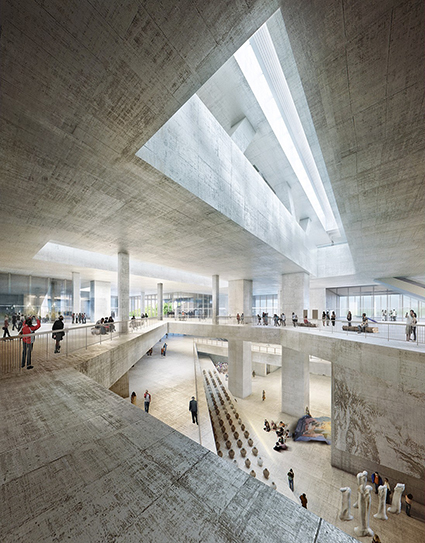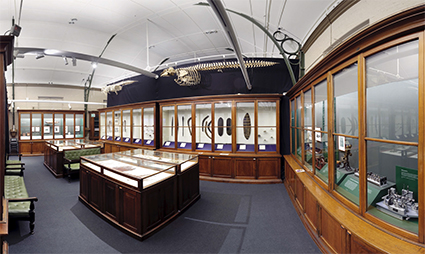Museums more or less
Jane Goodall: The Post-Museum, Part 2

Section from architects’ plans, M+ Museum, Hong Kong
image courtesy Brunswick Arts
Section from architects’ plans, M+ Museum, Hong Kong
Last year’s National Association for the Visual Arts (NAVA) summit Future/Forward (Carriageworks, 6-7 Nov, 2014) opened with a fine keynote address from Nikos Papastergiadis on the theme of art in a borderless world. In what sense, he asked, does art cross borders? Art does not do this ‘in and of itself,’ so what enables this new order of global mobility? These questions led to a consideration of changing cultural and aesthetic frameworks, and the potential for arts institutions to have a transformative influence.
A focus on new kinds of institutional presence was further developed in the second keynote lecture, from Hong-hee Kim, Director of the Seoul Museum of Art (SeMA). Her vision of the post-museum was articulated as a shift from order and control towards interpretation and flexibility, from an emphasis on collection to a foregrounding of curatorial enterprise extending beyond the confines of the building. SeMa brands itself as “a post-conventional, post-institutional art museum that comes after the time of neoliberalism.”
Carriageworks as the new
At Carriageworks, she was speaking to an audience of the converted. And Carriageworks itself, with its community markets and hybrid mix of exhibitions and performances is already a prototype for the kind of reinvention she was advocating. In Korea, the cultural shift associated with the idea of the post-museum has very different resonances from those we are familiar with in Australia.
Carriageworks is a massive industrial construction, a conversion of the former Eveleigh Rail Yards in which the space is still defined by massive iron girders and rail tracks that remain embedded in the floor. The art events presented here adapt themselves to the building, not the other way about. During the days of the NAVA conference, works by the Torres Strait Islander artist Ken Thaiday were exhibited in the main hall. These sculptural interpretations of traditional masks and sea creatures spoke of a deeper history and a cultural heritage divorced from that of Australian industrial modernity, yet the polarised aesthetic registers were a remarkably effective co-presence (see our video interview with Thaiday and images of his work).
SeMA, Seoul
Architecturally, SeMA reflects a more complex and politically stressed urban history. The main museum is now located in the Jeong-dong area, where the foundations of a cosmopolitan culture in Seoul were laid in the 1880s, with the opening of the US Legation, the British Embassy and diplomatic residences for delegates from France, Germany and Russia. But the building itself belongs to a subsequent political era. It is the former Keijo Court House, constructed in 1928 during the period of Japanese colonisation. Its architecture reflects the aesthetic control imposed by the Japanese administration, under which traditional Korean craftsmanship and building techniques were suppressed in favour of neo-classical western design. The building was repossessed as the Supreme Court of Korea after the liberation in 1945.
SeMA’s occupancy dates back to 2002, when the Supreme Court was moved to another district. The building was substantially remodelled for the museum, but as the stigma of its origins has faded from public awareness, its intrinsic qualities have come to be widely appreciated, and it is now an important landmark in the city’s architectural heritage. As a building, it is the marker of a series of massive cultural and political transitions, through periods of cosmopolitan enterprise, colonisation, war, independence and back to a new phase of global enterprise. Its self-declared identity as a post-museum, defined in antithesis to that of the colonial or classical museum, is part of this most recent transition.
Since 2000, SeMA has hosted the Mediacity Seoul Biennale, which reflects the city’s ethos of ‘media-frenzy’ and celebrates its internationalism. The 2014 festival began with a shamanistic ritual performed in traditional ceremonial robes “to cleanse any history of agony or tragedy left behind at the site of Seoul Museum of Art,” and then spread around the city with works from 17 countries. The celebration of a contemporary electronic environment infused with deep histories of conflict and trauma displays the post-museum agenda as something much more significant than a branding exercise in a competitive tourist market.
Heritage and nationalism as business
But the competitive tourist market is one of the realities to be negotiated in the 21st century museum world. Income has to come from somewhere, and league tables of visitor numbers, tourist ratings and internet hits creates a feedback loop: everyone wants to go where everyone wants to go. Inevitably, there is a nationalist edge to this competition. Paris, London, New York and Washington dominate the league tables for visitor numbers in 2014, though South East Asian museums are strengthening their hold in the top 20. Scale and spectacle are primary attractions, but the dominance of the Louvre, the National Museum of China, the Vatican Museum, the British Museum and the National Palace Museum in Taiwan indicates that antiquity is a major drawcard.
Does this mean that the post-museum is defining itself perversely in opposition to historic cultural institutions that remain at the forefront of the public imagination? Perhaps there have been some rather glib presumptions about what is ‘elite.’ The Louvre is a quintessentially aristocratic foundation, but cultural hierarchies are not constant, and part of its allure now is that anyone who can afford the admission price (about $13 AUS) can traipse through. At any hour of the day, the crowd staring at the Mona Lisa will be looking from many points of view. Some will have scholarly knowledge, and some will want to acquire it from expert guides. Some will be Dan Brown fans. Some will just be concerned to capture it in their cellphones. Whatever the anxieties and enthusiasms of the institutional staff who congregate at international forums about the reinvention of the museum, there is no getting away from the fact that heritage is core business. Visions of the future projected onto screens and evoked in hologram do not exert the same potent influence on the human psyche as the works of past visionaries, massively etched in stone and cast in bronze. There is no getting away, either, from the history of the museum as national symbol.
Hong Kong’s M+ rethinks the museum
The establishment of a major museum can be a bid to shift the epicentre of cultural capital, and this is clearly the case with Hong Kong’s M+ project. According to Executive Director Lars Nittve, M+ “means museum and more, museum and beyond.” The plans presented to him by the Hong Kong government, he says, were “very ambitious,” both in scale—the footprint was to be some 45,000 square metres —and in concept. He was charged with a mission “to rethink what the museum is in the 21st century and challenge the given models.”
With a six-year construction period and a completion date in 2017, architects Herzog and de Meuron are working to a tight time frame, but since the plan is for the museum to spill out of the building with exhibitions in the surrounding area, its opening does not have to be commensurate with the opening of the building itself. In contrast to SeMA, M+ will be a building without a past. The site is a stretch of reclaimed land bordering Victoria Harbor, on the edge of the West Kowloon cultural precinct. So even the ground is, in the words of the architects, “somehow innocent, virgin.” They envisage the structure as a “semi-transparent vertical plane,” the sides of which will serve as massive LED screens for the projection of images.
Arts into a single edifice
Conceptually, this expresses a bid to erase borders and boundaries of all kinds. Original plans for the site divided the space to accommodate four separate museums, dedicated to visual arts, popular culture, cinema and design, but this approach was abandoned in favour of merging them into a single edifice. Erasing the discipline boundaries, according to curator Tobias Berger, is “very Hong Kong,” as this is a place where people often excel in more than one profession and pride themselves on acquiring several channels of expertise and experience. Inside the building, visitors will be able to watch the experts at work, through transparent walls, so that every aspect of the process of preparing and planning an exhibition will go public.
All this amounts to a comprehensive fulfillment of the criteria by which the post-museum defines itself. The design and planning processes at M+ are led by people of extraordinary vision and talent, who are of course engaged in something more sophisticated than any box-ticking exercise. But one of the risks of the post-museum agenda is that it could too easily become a generic package, and a monolithic one at that.
While everyone loves the great turbine hall at the Tate Modern (also the work of Herzog and de Meuron), big isn’t always better. The lure of the monolith is part of the international museum tradition but upscaling can kill the appeal. Museums also serve to remind us that we humans are animals, and part of their appeal is to present us with an array of forms that are like and not like us.

Macleay Museum Gallery, Sydney, 2006
photo Michael Myers
Macleay Museum Gallery, Sydney, 2006
On a human scale
One of my favourite museums is the Macleay (see part 1 of this essay in RT125, p 10), housed in the Victorian Tudor building of that name in the grounds of Sydney University. Preserving the unique collection of specimens bequeathed by the Scottish naturalist Alexander Macleay (1767-1848) is an unashamed priority. Bottled reptiles, pinned insects and stuffed animals are displayed under glass, in polished cedar cabinets. Exhibitions are managed on a shoestring budget, occasionally augmented by funding for those that are part of a PhD program. This year the museum has hosted presentations from candidates in a variety of disciplines including history, archeology and the visual arts.
Places that relate to the scale of the human body can resonate deep in the psyche. Entering the Macleay is like going into a time-warp. With its aura of antiquarian science, the closely stocked interior also evokes a world of childhood dream and fantasy. Harry Potter—and any of his readers—would be on familiar ground here, and so would Lewis Carroll’s Alice, because they are denizens of a world whose boundaries shift and warp.
RealTime issue #126 April-May 2015 pg. 27-28






